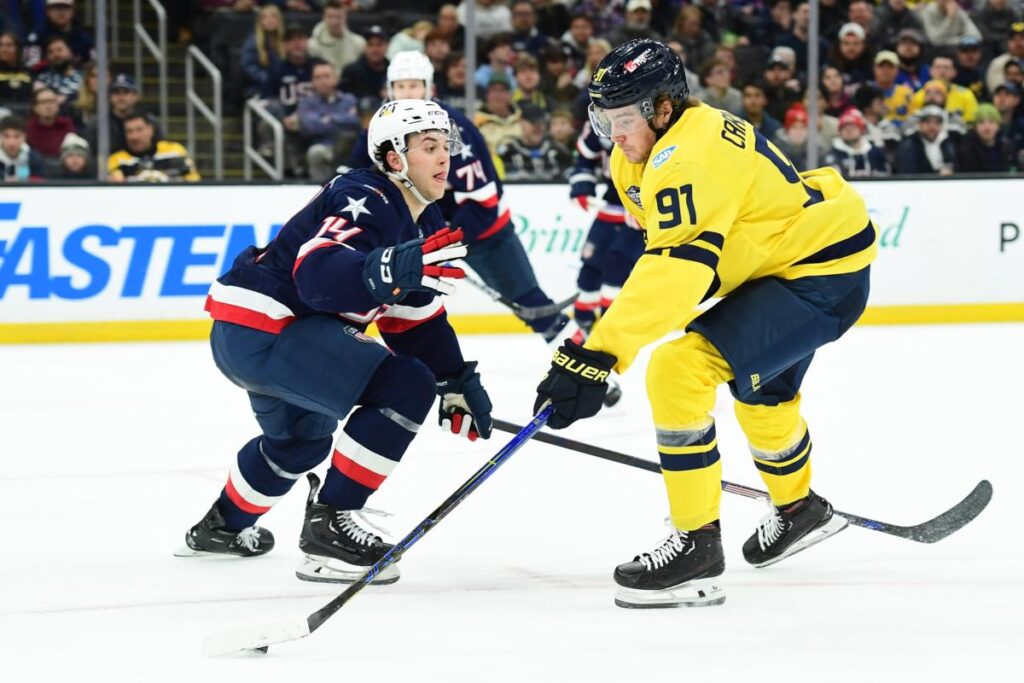
The NHL 4 Nations Face-Off is in the books and regular season games resumed on Saturday.
The Anaheim Ducks entered the break having won six of their last seven games and holding a .500 record (24-24-6). They’ve now added to the win column and are 25-24-6.
Leo Carlsson (20) was the only Ducks player selected to represent his country at the tournament. The remainder of the roster enjoyed an extended break with vacations and family time.
Though the NHL regular season was on hold, those who tuned into the 4 Nations were treated to some of the very best hockey ever played, grabbing attention with incredible skill and juicy storylines. The event was a roaring success.
The on-ice product was sensational throughout the seven-game, eight-day tournament. Every facet of the game was played at the highest level and on full display.
Here are some takeaways for the Anaheim Ducks to consider moving forward:
Extinction of the “Stay-at-Home” Defenseman
The element of the 4 Nations Face-Off that was perhaps most impressive wasn’t the dynamic speed of players like Nathan MacKinnon and Connor McDavid. It wasn’t the lightning-quick releases of players like Kyle Connor and Auston Matthews. It wasn’t even the creativity of players like Jesper Bratt and Mitch Marner.
Although those facets were dizzying at times in their brilliance, the way those players were defended all tournament long was truly eye-catching.
Against some of the fastest, most intelligent, and most skilled hockey players in the world, defensemen kept gaps close, consistently broke up plays with clever stick placements, and put on angling masterclasses, forcing plays to the perimeter in every zone.
Players like Brock Faber, Thomas Harley, (of course) Jacob Slavin, Gustav Forsling, and even Niko Mikkola fully showcased the evolution of what a shutdown defender is in the NHL.
Bygone are the days of bruising “stay-at-home” defenders who simply protect the middle of the ice and punish forwards who dare occupy ice in the slot. Modern attackers are so incredibly skilled and can score from distance at the drop of a hat that giving them any time and space will be exploited, as best displayed by Adrian Kempe’s goal against Canada in the tournament opener.
The Ducks currently employ three defensemen on their blueline that can be classified and have been used as traditional shutdown defenders: Radko Gudas, Brian Dumoulin, and Jacob Trouba. Dumoulin epitomizes the modern trend of shutdown defensemen, while Trouba and Gudas play a more traditional stay-at-home style, which is counterintuitive to how the Ducks want to play and has led to a good deal of goals and opportunities against them this season.
Get Carlsson into Space
Leo Carlsson only appeared in one game for Sweden at the 4 Nations Face-Off. He played 14:37 and registered a shot on goal in the meaningless penultimate USA vs Sweden game of the tournament. He wasn’t a game-changer by any means for Sweden, didn’t look out of place, and noticeably gained comfortability and confidence as the game progressed.
One area of Carlsson’s game that needs growth is on the cycle. In his lone game of the tournament and when his line had established pressure in the offensive zone, he would head to the front of the net to establish body position when he didn’t have possession. Once there, he had a difficult time winning those battles or finding soft ice to present himself as a passing option.
When comparing his off-puck tendencies to those of his occasional linemate, William Nylander, Carlsson could stand to study Nylander’s habits. Nylander darts in and out of the slot when the puck moves low to high and is constantly searching for open ice.
Carlsson is at his best when he’s moving his feet and when the puck is on his stick. When he’s simplifying his game so much, he’s doing neither of those things and rendering himself ineffectual.
Disrupt in the Neutral Zone
In this tournament, 31 goals were scored at 5v5. Of those 31 goals, 16 were scored off the rush. The Ducks thrive most offensively when attacking on the rush, as they and head coach Greg Cronin have noted multiple times.
Clean breakouts are one way to ignite rush opportunities, and another is to manufacture turnovers in the neutral zone to catch opponents on their heels.
The Ducks have been running a set 1-1-3 neutral zone forecheck to eliminate rush chances from their opponent. It has proved effective at denying entry at the blueline for the most part, often forcing chips or dumps.
However, they aren’t causing the necessary neutral zone turnovers so they can build an effective counterattack. An adjustment would be to revert to a 1-2-2, fill passing lanes, and pressure the puck carrier after attackers exit their zone.
Players like Trevor Zegras, Troy Terry, Mason McTavish, and Leo Carlsson are all excellent when diagnosing opposing structures and have proved disruptive when playing an F2 or F3 role. They can read, anticipate, and even manipulate attackers from the opposite side of the ice before “jumping routes” and picking off passes.
This added layer could be a key to unlocking the brimming offensive potential of the team, especially with their youngest and most talented players.
#Ducks #Takeaways #Nations #FaceOff


